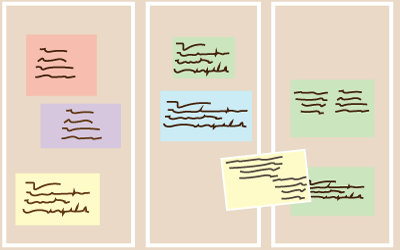 As we have seen, the project life cycle comprises the set of phases into which a project is organized. Depending on the organization in question and any overlapping between phases, various types of project life cycle can be defined: predictive or classic life cycles define the product and deliverables at the start of the project; iterative or incremental life cycles adopt an approach that gradually increases or expands the product in steps; and adaptive or flexible life cycles develop the product through numerous iterations, with the scope for each iteration only defined at the start thereof.
As we have seen, the project life cycle comprises the set of phases into which a project is organized. Depending on the organization in question and any overlapping between phases, various types of project life cycle can be defined: predictive or classic life cycles define the product and deliverables at the start of the project; iterative or incremental life cycles adopt an approach that gradually increases or expands the product in steps; and adaptive or flexible life cycles develop the product through numerous iterations, with the scope for each iteration only defined at the start thereof.
Try managing classic, iterative and flexible project life cycles in ITM Platform
Predictive, classic or planning-focused life cycles
Predictive life cycles (also known as classic or planning-focused life cycles) are those in which the scope, deadline and cost are determined as soon as possible in the project life cycle and efforts are focused on meeting the commitments established for each one of these factors.
These projects are normally organized into a series of sequential or consecutive phases, where each one is focused on a specific sub-product or activity. Normally, the work undertaken in one phase is very different to all the rest and so the project team will vary according to the phase under way at any given time.
From the start, project management focuses on defining the scope and drawing up a detailed plan of the necessary activities. From there, work is focused on following the plan. Any project scope change must be managed explicitly and usually leads to a review of the plan and formal acceptance of the new plan.
Predictive life cycles are chosen when the product to be delivered is well-defined and relatively extensive knowledge exists on how to build the product. This has traditionally been the most common work model but does not necessarily suit the circumstances of all projects and organisations.
Iterative or incremental life cycles
Iterative or incremental life cycles are those in which the activities of the project are repeated in phases or iterations and understanding of the product by the project team increases in each one. The iterations develop the product through a series of repeated cycles that successively add functionality to the product.
At the end of each iteration, a deliverable or set of deliverables will have been produced. Future iterations may improve said deliverables or create new ones. The final product will be the accumulation of functionalities built up during the various iterations.
Iterative or incremental life cycles are chosen when it is necessary to manage vague objectives or considerable complexity, or when the partial delivery of the product is key to success. This type of life cycle enables the project team to incorporate feedback and gradually increase the experience of the team during the course of the project.
Adaptive or flexible life cycles
Adaptive life cycles, also known as change-focused methods or flexible methods, respond to high levels of change and to ongoing participation by the interested parties.
There are two basic models for this type of life cycle, those focused on the flow (for example, Kanban) and others focused on iterative and incremental cycles (for example, Scrum). Very clear limitations are set on the concurrence of activities (Work in Progress) for the former and on very rapid iterations (between 1 and 4 weeks) in which the work is done for the latter (Sprint).
In flexible models, the overall scope of the project will usually be broken down into a set of requirements or projects to be undertaken (sometimes called Product Backlog). At the start of an iteration, the team defines the functionalities to be tackled in that cycle. At the end of each iteration, the product should be ready for review by the client. This type of life cycle requires teams to be highly involved and the sponsor or client to provide constant feedback.
Generally-speaking, flexible methods are chosen in environments that change swiftly, when the scope is unclear or when the value contribution is highly variable and with highly involved teams.

